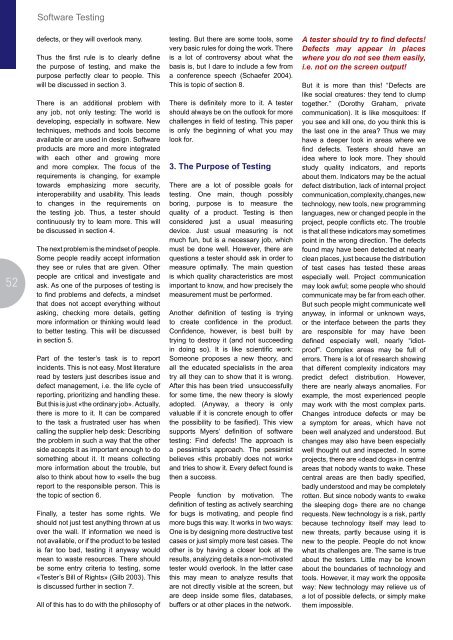Comparison of Change Management Systems
Comparison of Change Management Systems
Comparison of Change Management Systems
You also want an ePaper? Increase the reach of your titles
YUMPU automatically turns print PDFs into web optimized ePapers that Google loves.
52<br />
S<strong>of</strong>tware Testing<br />
defects, or they will overlook many.<br />
Thus the first rule is to clearly define<br />
the purpose <strong>of</strong> testing, and make the<br />
purpose perfectly clear to people. This<br />
will be discussed in section 3.<br />
There is an additional problem with<br />
any job, not only testing: The world is<br />
developing, especially in s<strong>of</strong>tware. New<br />
techniques, methods and tools become<br />
available or are used in design. S<strong>of</strong>tware<br />
products are more and more integrated<br />
with each other and growing more<br />
and more complex. The focus <strong>of</strong> the<br />
requirements is changing, for example<br />
towards emphasizing more security,<br />
interoperability and usability. This leads<br />
to changes in the requirements on<br />
the testing job. Thus, a tester should<br />
continuously try to learn more. This will<br />
be discussed in section 4.<br />
The next problem is the mindset <strong>of</strong> people.<br />
Some people readily accept information<br />
they see or rules that are given. Other<br />
people are critical and investigate and<br />
ask. As one <strong>of</strong> the purposes <strong>of</strong> testing is<br />
to find problems and defects, a mindset<br />
that does not accept everything without<br />
asking, checking more details, getting<br />
more information or thinking would lead<br />
to better testing. This will be discussed<br />
in section 5.<br />
Part <strong>of</strong> the tester’s task is to report<br />
incidents. This is not easy. Most literature<br />
read by testers just describes issue and<br />
defect management, i.e. the life cycle <strong>of</strong><br />
reporting, prioritizing and handling these.<br />
But this is just «the ordinary job». Actually,<br />
there is more to it. It can be compared<br />
to the task a frustrated user has when<br />
calling the supplier help desk: Describing<br />
the problem in such a way that the other<br />
side accepts it as important enough to do<br />
something about it. It means collecting<br />
more information about the trouble, but<br />
also to think about how to «sell» the bug<br />
report to the responsible person. This is<br />
the topic <strong>of</strong> section 6.<br />
Finally, a tester has some rights. We<br />
should not just test anything thrown at us<br />
over the wall. If information we need is<br />
not available, or if the product to be tested<br />
is far too bad, testing it anyway would<br />
mean to waste resources. There should<br />
be some entry criteria to testing, some<br />
«Tester’s Bill <strong>of</strong> Rights» (Gilb 2003). This<br />
is discussed further in section 7.<br />
All <strong>of</strong> this has to do with the philosophy <strong>of</strong><br />
testing. But there are some tools, some<br />
very basic rules for doing the work. There<br />
is a lot <strong>of</strong> controversy about what the<br />
basis is, but I dare to include a few from<br />
a conference speech (Schaefer 2004).<br />
This is topic <strong>of</strong> section 8.<br />
There is definitely more to it. A tester<br />
should always be on the outlook for more<br />
challenges in field <strong>of</strong> testing. This paper<br />
is only the beginning <strong>of</strong> what you may<br />
look for.<br />
3. The Purpose <strong>of</strong> Testing<br />
There are a lot <strong>of</strong> possible goals for<br />
testing. One main, though possibly<br />
boring, purpose is to measure the<br />
quality <strong>of</strong> a product. Testing is then<br />
considered just a usual measuring<br />
device. Just usual measuring is not<br />
much fun, but is a necessary job, which<br />
must be done well. However, there are<br />
questions a tester should ask in order to<br />
measure optimally. The main question<br />
is which quality characteristics are most<br />
important to know, and how precisely the<br />
measurement must be performed.<br />
Another definition <strong>of</strong> testing is trying<br />
to create confidence in the product.<br />
Confidence, however, is best built by<br />
trying to destroy it (and not succeeding<br />
in doing so). It is like scientific work:<br />
Someone proposes a new theory, and<br />
all the educated specialists in the area<br />
try all they can to show that it is wrong.<br />
After this has been tried unsuccessfully<br />
for some time, the new theory is slowly<br />
adopted. (Anyway, a theory is only<br />
valuable if it is concrete enough to <strong>of</strong>fer<br />
the possibility to be fasified). This view<br />
supports Myers’ definition <strong>of</strong> s<strong>of</strong>tware<br />
testing: Find defects! The approach is<br />
a pessimist’s approach. The pessimist<br />
believes «this probably does not work»<br />
and tries to show it. Every defect found is<br />
then a success.<br />
People function by motivation. The<br />
definition <strong>of</strong> testing as actively searching<br />
for bugs is motivating, and people find<br />
more bugs this way. It works in two ways:<br />
One is by designing more destructive test<br />
cases or just simply more test cases. The<br />
other is by having a closer look at the<br />
results, analyzing details a non-motivated<br />
tester would overlook. In the latter case<br />
this may mean to analyze results that<br />
are not directly visible at the screen, but<br />
are deep inside some files, databases,<br />
buffers or at other places in the network.<br />
A tester should try to find defects!<br />
Defects may appear in places<br />
where you do not see them easily,<br />
i.e. not on the screen output!<br />
But it is more than this! “Defects are<br />
like social creatures: they tend to clump<br />
together.” (Dorothy Graham, private<br />
communication). It is like mosquitoes: If<br />
you see and kill one, do you think this is<br />
the last one in the area? Thus we may<br />
have a deeper look in areas where we<br />
find defects. Testers should have an<br />
idea where to look more. They should<br />
study quality indicators, and reports<br />
about them. Indicators may be the actual<br />
defect distribution, lack <strong>of</strong> internal project<br />
communication, complexity, changes, new<br />
technology, new tools, new programming<br />
languages, new or changed people in the<br />
project, people conflicts etc. The trouble<br />
is that all these indicators may sometimes<br />
point in the wrong direction. The defects<br />
found may have been detected at nearly<br />
clean places, just because the distribution<br />
<strong>of</strong> test cases has tested these areas<br />
especially well. Project communication<br />
may look awful; some people who should<br />
communicate may be far from each other.<br />
But such people might communicate well<br />
anyway, in informal or unknown ways,<br />
or the interface between the parts they<br />
are responsible for may have been<br />
defined especially well, nearly “idiotpro<strong>of</strong>”.<br />
Complex areas may be full <strong>of</strong><br />
errors. There is a lot <strong>of</strong> research showing<br />
that different complexity indicators may<br />
predict defect distribution. However,<br />
there are nearly always anomalies. For<br />
example, the most experienced people<br />
may work with the most complex parts.<br />
<strong>Change</strong>s introduce defects or may be<br />
a symptom for areas, which have not<br />
been well analyzed and understood. But<br />
changes may also have been especially<br />
well thought out and inspected. In some<br />
projects, there are «dead dogs» in central<br />
areas that nobody wants to wake. These<br />
central areas are then badly specified,<br />
badly understood and may be completely<br />
rotten. But since nobody wants to «wake<br />
the sleeping dog» there are no change<br />
requests. New technology is a risk, partly<br />
because technology itself may lead to<br />
new threats, partly because using it is<br />
new to the people. People do not know<br />
what its challenges are. The same is true<br />
about the testers. Little may be known<br />
about the boundaries <strong>of</strong> technology and<br />
tools. However, it may work the opposite<br />
way: New technology may relieve us <strong>of</strong><br />
a lot <strong>of</strong> possible defects, or simply make<br />
them impossible.



